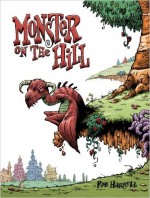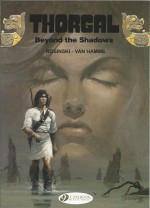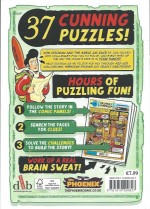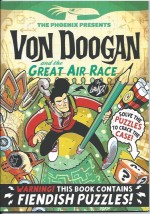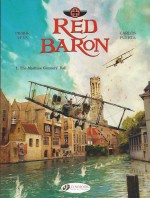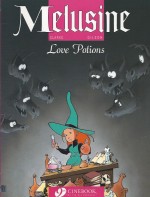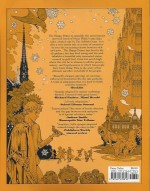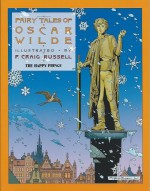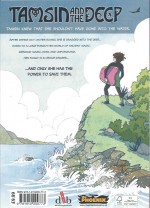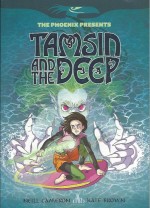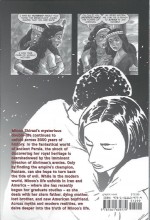

By Dara Naraghi & Brent Bowman (NBM/ComicsLit)
ISBN: 978-1-56163-977-9
All creative people are a little bit chained to their art-form, and Iranian ex-pat Dara Naraghi far more so than most. As well as his own celebrated Big City Blues comic he’s been responsible for adapting to comics such licensed properties as Robert Patterson’s Witch & Wizard novels, Terminator: Salvation, It! The Terror From Beyond Space and Ghostbusters, writing for DC, Image and IDW and running his own publishing house Ferret Press.
His breakthrough graphic anthology Lifelike set new standards for expressive exploratory tale-telling and he was a founding member of comics creators collective PANEL. He also scripts (and occasionally draws) utterly wonderful tales covering every aspect of the human experience from wild fantasy to chilling slice-of-life in a splendid series of webcomics.
Artist and illustrator Brent Bowman has created art for the Age of Empires collector card game and worked at Caliber Press and Image Comics. He too is a member of PANEL, devoted to pushing the envelope (probably after covering it with doodles and sketches) of graphic narrative.
Together they have conceived a trilogy of graphic novels cunningly blending real-world reportage with fantastic fantasy in a mythic manner both intriguing and captivating. Initial outing Persia Blues: Leaving Home won the 2014 Small Press & Alternative Comics Expo prize for Best Graphic Novel.
That tome introduced spirited young woman Minoo Shirazi who had a history of troublemaking and parental issues in two very different worlds dubbed for discomfort “There†and “Hereâ€â€¦
Far away and long ago a bold warrior woman with an inexplicable incendiary power in her hands battled beside her lover Tyler against brigands and worse to retrieve a holy book in the heyday of the Persian Empire. We’ll call that “Hereâ€â€¦
Over “There†in our world, a forthright, independent Iranian architecture student named Minoo was seen at various moments of her life, constantly challenging the authority of her father and the far more dangerous agents of the theocracy…
In Ancient Persia the war-woman painfully and at first-hand learned of the eternal struggle between the light of Ahura Mazda and dark evil of demonic Ahriman, before becoming embroiled in the struggle – as did her scholarly lover – when a priest was slaughtered by the devil-lord Himself.
A giant, wingless talking griffon then despatched them to distant Persepolis to meet her long-lost mother. The divine messenger also decreed Minoo the Warrior would play a crucial role in the battle between good and evil and must accept her fate…
En route, they encountered famed and legendary Anusiya battling an horrific army of scorpion men and other beasts. Dashing to join the hard-pressed Persian Royal Guard, they turned the tide and the grateful soldiers escorted them to an audience with the Emperor…
In modern times when word of Minoo’s latest brush with the authorities reached her father, once-eminent history professor Bijan Shiraz took unwelcome and unwanted steps to protect the last member of his family.
For years he had been a thorn in the side of the religious fundamentalists rewriting and revising the grand and glorious history of Persia to suit the self-serving demands of a theocratic, clerical dictatorship and consequently his entire family had suffered…
Bijan and his wife Manijeh argued for years. She wanted the family to leave but the scholar refused to leave the proud history of Persia in the hands of revisionists. Minoo often listened, terrified her parents were divorcing, but older brother Ramin was always there to calm her fears…
Three years ago Minoo and her father discussed her recent graduation. Her prospects had long been a brittle bone of contention, and she would not accept the aging intellectual’s argument that she should pursue a Master’s Degree. Not in a country that openly suppresses choice and opportunity for women…
She was utterly astounded when he reveals he had changed his mind and would use all his resources, contacts and waning influence to secure her a University place outside Iran…
And in Persepolis the supreme ruler is revealed as Empress Purandokht, Queen and Protector of the Persian Empire who greets her wandering daughter but does not recognise her…
This is a tale of interconnected contrasts, with the modern scenes – deliberately convoluted by mixing the chronological sequence of flashback events – rendered in stark black line whilst the exotic and thrilling Persian adventure is presented as lush, painterly pencil-grey tones.
Moreover, although the general dialogue and idiom of the ancients is what you’d expect in an historical drama, Tyler and mystic Minoo speak like American 20-somethings, eventually admitting to Purandokht they are from somewhere called “Columbusâ€â€¦
Following a graphic reintroduction to the major players and a quick recap in ‘Our Story Thus Far’ the twin-tracked tale-telling recommences over “There†in Tehran eleven years ago as young teenager Minoo goes ski-boarding for the first time and meets a boy. Over-protective Ramin’s response is not what she anticipated…
Way back “Here†Tyler and Minoo soon get bored cooling their heels in the palace and – avoiding Purandokht’s hyper-maternal oversight – sneak out to find the nation’s ultimate hero Rostam who might be the only hope to defeat Ahriman’s converging dark forces…
Modern Minoo meanwhile is still settling in at the University of Ohio in America. It is one year ago…
Her fellow Students are all very welcoming but the culture is so different in its minutiae and daily details. However, when she introduces herself to her father’s old friend Professor Yazdi she finds him with a charming young man discussing his Graduate Degree. His name is Tyler Clarke and he is obsessed with the culture and history of Iran. Even more so apparently, after meeting Minoo…
In the wilds of Persia, a wild ride and valiant quest at last leads the strange warriors to mighty Rostam and his wonder steed Rakhsh. Finishing off the demon he has been toying with the heroic marvel joyously accompanies them back to embattled Persepolis…
In Columbus as Tyler and Minoo get better acquainted, the scene suddenly shifts to Iran twelve years previously. The Shiraz family are fragmenting and the kids are dealing with Bijan and Manijeh’s divorce very differently. Jumping ahead seven years, the dutiful daughter is still arguing with dad after he’s been beaten up… again…
Rostam’s tumultuous return to Persepolis is none too soon: his glorious welcome parade is barely begun when the monster armies of Ahriman turn up…
Ten years ago in Tehran, Minoo finally gets to watch football-crazy Ramin play, even if the trip nearly gets her arrested. It’s the best game of his life and the last time she will ever see him…
The battle for Persepolis is long and hard and only the direct intervention of Ahura Mazda saves overmatched Minoo when her flame powers fail…
In America six months ago Tyler took Minoo camping and learned a lot about her, such as her family history and troubles and the fact that she is a demon with a game console…
“Here†as Persepolis reels from the catastrophic assault, “There†in Tehran twenty-one years ago another parental clash left Minoo alone with Daddy, who proudly read his little girl the far-from-bedtime story of the Seven Labours of Rostam…
Although forced from the battlefield Ahriman is undeterred and directly attacks Purandokht in the palace. Although her formidable daughter is in time to drive the devil off, the queen is stricken by the beast’s poisons…
In Tehran eleven years ago the fractured family gather at the hospital. Manijeh’s chemotherapy has failed and surgery is now the only option. Minoo cannot comprehend her father’s reactions…
As before, glimpses of a greater truth come from a brace of Epilogues. The first sees Minoo in Columbus three months ago: Skypeing with the dad she still doesn’t trust but blithely unaware of the trouble he’s in, whilst the second focuses on Persepolis where a distraught daughter is confronted by the all-wise Griffon. He challenges the warrior woman’s understanding of her strangely incomplete existence and asks difficult questions about the father she cannot remember…
To Be Concluded…
Gilded with excerpts of classical poetry by Rumi (13th century Persian poet, jurist, scholar, theologian and Sufi Mystic JalÄl ad-DÄ«n Muhammad RÅ«mÄ« AKA JalÄl ad-DÄ«n Muhammad BalkhÄ« or simply “our masterâ€: very cool and totally worthy of your further attention…), this is a smart and subtle melding past and present, fact and fiction, revelling in exploiting reader expectation and confusion whilst crafting a beguiling multi-layered tale of family, responsibility, guilt, oppression and the hunger for independence which carries the reader along, promoting wonder and second-guessing whilst weaving a tantalising tapestry of mystery.
Engaging, rewarding and just plain refreshingly different, Persia Blues looks set to become a classic for all time…
© 2015 Dara Naraghi and Brent Bowman.


